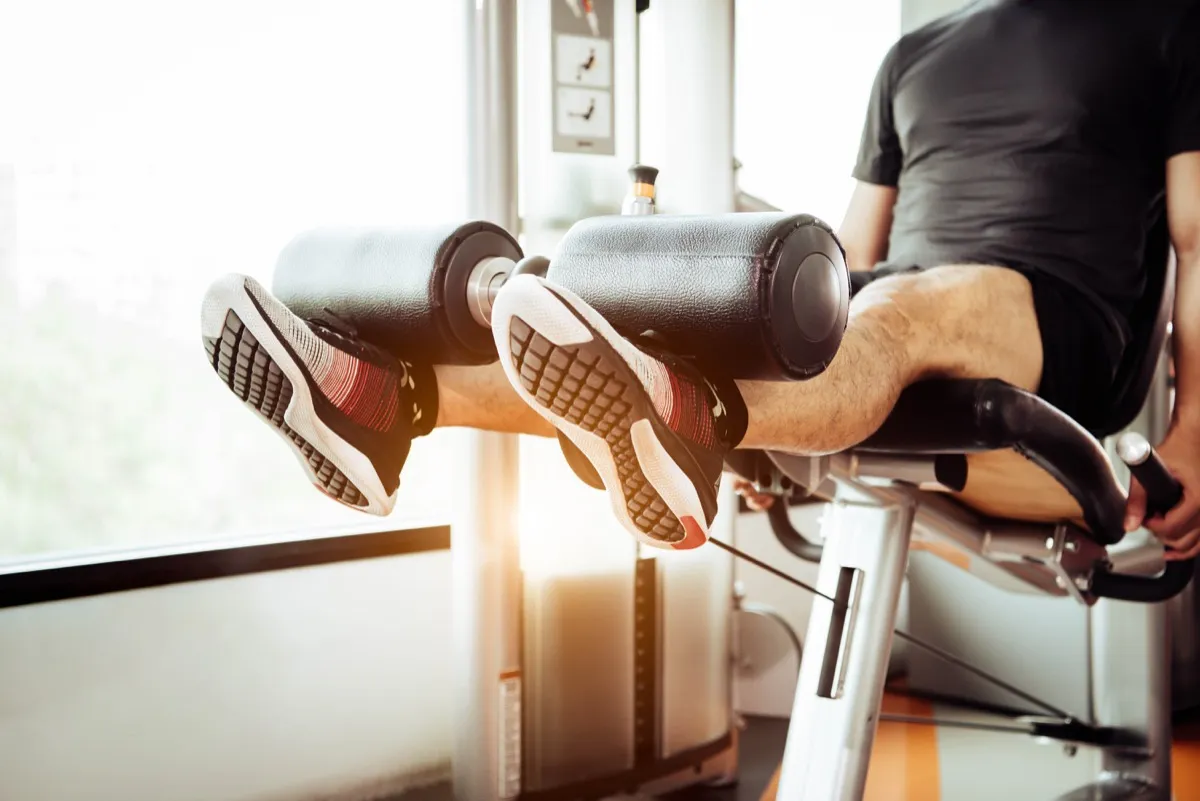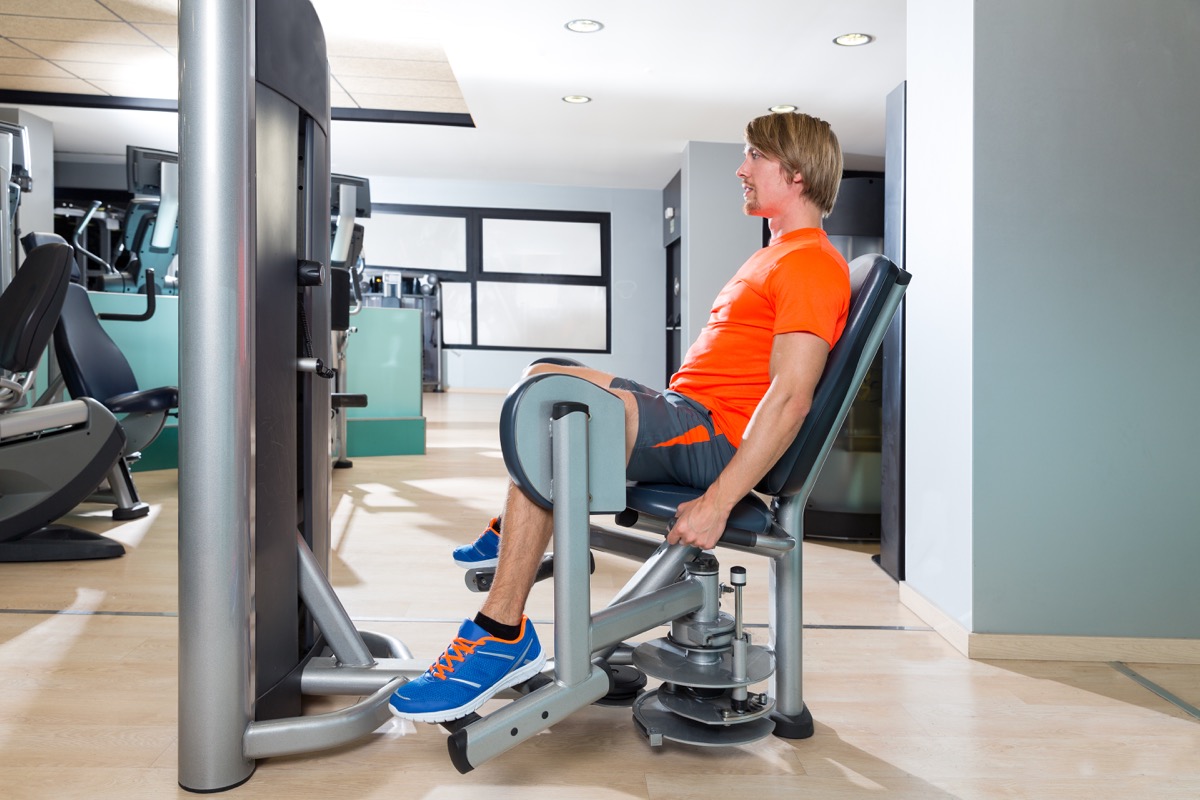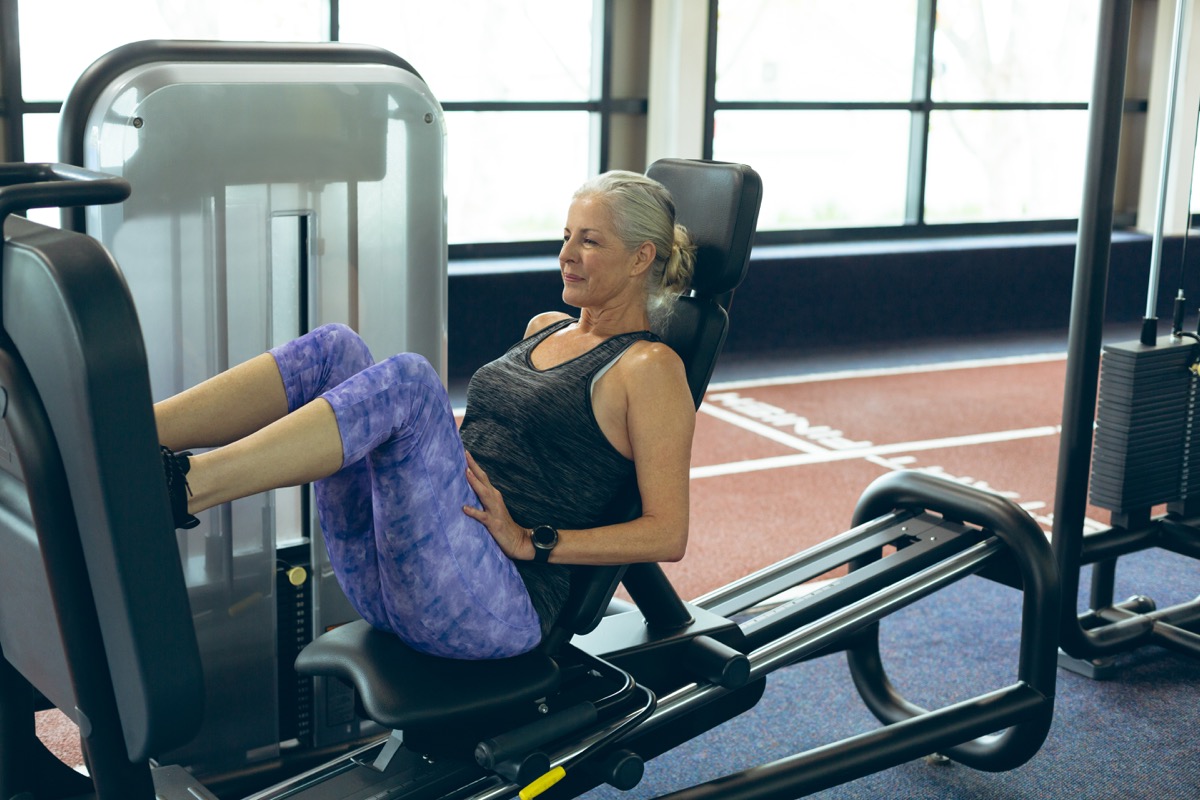13 Exercises You Should Avoid, According to Personal Trainers

Making time to work out is hard, so when you’re actually breaking a sweat, you want to use your time wisely. And while any type of exercise that gets you moving is good for you, there are some moves that are more effective (and safer) than others. Why waste your energy on workouts you should be avoiding? To help you make the most out of your time at the gym, here are the 13 worst exercises you should skip—and what to do instead.
1
Dumbbell Side Bends

When you want to cinch your waist and tighten your love handles, dumbbell side bends might be your choice of movement. The problem? This exercise doesn’t actually engage the obliques at all, says performance specialist Matt Cheng, CSCS.
“Most of the time, it involves too much lateral bending and twisting of the spine,” he explains. Instead, Cheng recommends doing hanging oblique knee raises on a bar. “These target the same oblique muscles while taking the pressure off your spine.”
How to do hanging oblique knee raises: Grip both hands around a pull-up bar and hang with your feet together and your body straight. Without swinging, bend your knees together and draw them up toward your right arm. Then, bring your feet back down together. Alternate sides.
2
Supermans

The superman is a bodyweight exercise known for targeting the lower back. However, “this exercise forces our lower back to overextend repetitively and only contributes to bad patterns and more back pain,” Cheng says.
As a better alternative, reverse back extensions allow your back to extend fully without hyperextending it. As an added bonus, they also tighten your glutes and core, which helps support your lower back and prevent pain.
How to do reverse back extensions: Lie on your stomach on top of a stability ball with your hands and feet on the ground, hip distance apart. Tightening your entire posterior (including your back, glutes, legs, and core), press your legs together and lift both feet off the ground until they’re parallel to the floor, then slowly lower them all the way back down.
3
Behind-the-Neck Presses

This popular bodybuilding exercise helps strengthen the shoulders, upper back, and triceps. However, it’s one of the least effective exercises for building upper body strength because it can actually put a strain on your neck and shoulder muscles. Standing with good posture is also key to this exercise, so if you have rounded shoulders and upper back, then you risk injury.
“What makes this exercise ineffective is that most of us have poor shoulder mobility due to our jobs or daily phone use,” Cheng says. For a safer and much more effective exercise, he suggests trying the dumbbell Arnold press. This move targets the front and back deltoids as well as the triceps.
How to do the Arnold press: Stand with your feet shoulder width apart and hold two dumbbells in front of you at chest height with your palms facing your body. Think: the position at the top of a bicep curl. Rotate the palms of your hands so they’re facing forward as you lift the dumbbells overhead, fully extending your arms until your biceps are by your ears. Make sure to keep your shoulders back and down and avoid arching your back. Lower the weights back to the starting position.
4
Barbell Jump Squats

If you’re trying to tone your glutes and legs, weighted plyometric exercises like the barbell jump squat might be top of mind. But when you use a barbell in exercises like this, you tend to add too much weight, which can put pressure on your back and joints, Cheng says.
To harness strength in these same muscles, he recommends bodyweight squat jumps, box jumps, and dumbbell jump squats instead. “Just mastering the bodyweight jump squat or changing the placement of the weight will make a big difference in the way you move and will save you from a lot of pain.”
How to do jump squats: Stand with your feet hip distance apart. Tightening your glutes and quads, sit back into your heels and push your butt back and down while keeping your chest lifted. Press your feet firmly on the ground as you jump up, swinging your arms back, and gently land on your feet.
5
Leg Extension Machines

Though some exercise machines are great for correcting form and targeting specific muscle groups, the leg extension machine isn’t one of them. “The leg extension machine applies constant tension to the anterior cruciate ligament (ACL) and increases the risk of the patella (knee cap) sliding right or left,” explains Chris Ryan, CSCS, a founding trainer of Mirror. “It also places maximum force on the back of the knee cap, which is the thinnest portion of the cartilage.”
Ryan advises doing squats, deadlifts, lunges, and Bulgarian split squats to build strong quads and glutes instead. Single leg exercises are especially great, as they will prevent muscle imbalances while challenging your stability and coordination.
How to do a lunge: Stand tall with your feet hip width apart. Take a big step forward with your right leg and lower your body until your thigh is parallel to the floor, making sure your knee doesn’t go past your foot. Your left knee and shin should also be parallel to the floor. Return to standing position. Repeat this move on both legs.
6
Smith Machine

Smith machines are commonly used to do a variety of barbell exercises, including back squats and deadlifts. The problem with this machine, though, is that it has a fixed bar path. “This forces users to move with the machine rather than with their own natural movement. People move in a multitude of ways based on height, mobility, and other constraints,” Ryan explains.
According to Ryan, the fixed bar can lead to injury because it overloads the joints on a movement path that may feel unnatural to you. It’s best to use dumbbells, resistance bands, or kettlebells to do functional movements like presses, pulls, squats, and lunges.
How to do a dumbbell squat: Stand with your feet hip distance apart holding a dumbbell in each hand. Tightening your glutes and quads, sit back into your heels and push your butt back and down, making sure to keep your chest lifted. Press your feet firmly on the ground as you stand back up.
7
Crunches

The reason why crunches are on this list is because most people don’t do them properly. “People think quantity is better than quality, and crunches are easy for most people to crank out at a high number of reps at very low-quality movement,” says Ryan. “Building your strongest core is all about building time under tension safely.” He suggests creating a strong core by doing a variety of leg lifts, overhead movements with arms extended, and rotational exercises like the medicine ball wood chop.
How to do medicine ball wood chops: Grab a medicine ball and stand with your feet hip distance apart with a slight bend in your knees. Rotate your torso to bring the medicine ball towards your left shoulder, arms fully extended. Then, chop the ball down diagonally across your body toward your right knee. Bring the ball back to the starting position and alternate sides.
8
Biceps Curl Machine

The bicep curl machine doesn’t allow for the full range of motion an actual curl with weights offers. Plus, it can cause issues with posture and form. A traditional bicep curl with dumbbells perfects your posture by ensuring that your shoulders stay back and down and that the only movement in your upper body is from your forearms.
How to do a bicep curl: Hold a dumbbell in each hand, keeping your elbows close to your torso. Press your shoulders back and down to anchor your upper body in place. Bend your elbows to lift the weights up until your biceps are contracted, around shoulder level. Take a brief pause to squeeze the biceps before you lower the dumbbells back to the starting position.
9
Hip Abduction Machine

This machine is intended to target the small muscles in your hips known as your abductors that are responsible for extending your legs away from your midline. However, it isn’t nearly as effective as other glute exercises that activate the same muscles, says Rachel MacPherson, an ACE-certified trainer and weight loss health coach.
“If you really wish to grow nice, rounded glutes and avoid injury, it’s best to use these muscles in the way they are designed to be used. Using a lopped band while squatting, hip thrusting, or deadlifting provides resistance to your abductors,” she says.
How to do a resistance band squat: Loop a mini band around your legs just above your knees and stand with your feet hip distance apart. Tightening your glutes and quads, sit back into your heels and push your butt back and down while keeping your chest lifted. You should feel the tension in the band as you widen your knees out to the sides. Press your feet firmly on the ground as you stand back up.
10
Leg Press Machine

Another exercise machine at the gym that you might want to avoid is the leg press. “The stabilizer muscles aren’t activated when using a leg press,” MacPherson explains. “The machine stabilizes you to the extent that you are not turning on the muscles utilized during weighted squats.”
For a more effective move, try squatting with dumbbells, kettlebells, and barbells. These movements not only tone up and sculpt your glutes, but also your core.
How to do a goblet squat: Stand with your feet shoulder distance apart and hold a dumbbell or kettlebell with both hands by your chest, elbows pointing down. Tightening your glutes and core, sit back into your heels and push your butt back and down. Avoid allowing your knees and ankles to cave inward. Push off your heels to stand back up.
11
Upright Rows

Though upright rows effectively target the shoulders, Ashlee Van Buskirk, a Colorado-based trainer and owner of Whole Intent, says they also compress the nerves when you lift the weight toward your chin.
“With excessive weight and too many reps, this exercise is the perfect recipe for a rotator cuff injury,” she explains. “There are other exercises that are far safer and more effective for your shoulders, like straight arm raises and resistance band pull-aparts.”
How to do resistance band pull-aparts: Stand with your feet shoulder distance apart. Hold a resistance band in front of you with both hands with your arms extended. Without bending your elbows and wrists, begin to pull the band out to the sides, bringing the band toward your chest. Keep your shoulders back and down throughout the entire movement.
12
Behind-the-Neck Lat Pull-Downs

Lat pull-downs are one of the most effective ways to correct posture and develop upper back muscles. Lat pull-downs behind the neck, on the other hand, often lead to injury.
“When you do lat pull-downs behind your neck, you thrust your head and neck forward, which can result in serious muscle strains and spinal issues,” Van Buskirk explains. Doing this exercise with the cable in front of you will keep your spine properly aligned.
How to do a lat pull-down: Sit on the machine with your feet flat on the floor and adjust the knee pads according to your height. Hold on to the bar with your hands shoulder distance apart and your arms fully extended. Without moving your torso and with your chest lifted, pull the bar down until it hits your upper chest. You should feel your back muscles tightening in this position. Release the bar by lifting it back to the starting position with your arms extended.
13
Russian Twists

Russian twists might give the effect of cinching, but in reality, they’re not effective if you don’t do them properly. As Robert Herbst, a 19-time World Champion powerlifter and personal trainer, explains, “Russian twists and their variations are bad unless you do that movement in a sport because of the stress they put on your lumbar discs. It is better to do exercises where the core is working statically, such as squats, lunges, and planks.”
How to do a plank: Start in tabletop position on a mat with your shoulders directly over your wrists and your hips in line with your knees. Tightening your abs, shoulders, and glutes, extend your legs behind you so that they are straight and lifted off the floor. Hold for as long as you can. Make sure that your butt isn’t raised or your stomach is sinking.